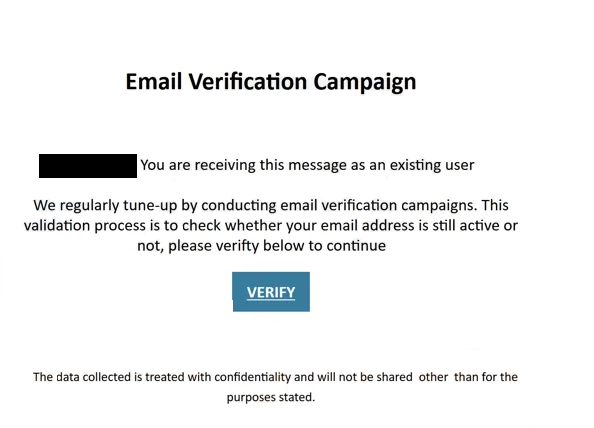Remove “Email Verification Campaign” phishing email
The “Email Verification Campaign” email is part of a phishing campaign that intends to steal users’ email login credentials. The email is disguised as a security alert from the recipient’s email provider and claims that they need to verify that the email account is still in use. Recipients are asked to click the provided “Verify” button to verify their accounts. However, if users click on it, they will be taken to a phishing site that imitates the legitimate email login page. If users type in their login credentials, they will be immediately stolen by the cybercriminals operating this phishing campaign. This could lead to users’ accounts being hijacked.
The “Email Verification Campaign” informs users that the email service provider is conducting an email verification campaign to check whether email addresses are active. Users who receive the email are asked to verify that they are using the address. The “Email Verification Campaign” phishing email contains a “Verify” button that, when clicked, directs users to a phishing website mimicking a legitimate email provider’s login page. If users mistakenly enter their account credentials there, those credentials will be captured by the cybercriminals behind the phishing campaign.
Email credentials are particularly valuable to malicious actors, as email accounts contain a wealth of personal information and are often linked to numerous other accounts. If an email account is successfully compromised, it can lead to the hijacking of connected accounts as well. Thus, users need to guard their email login credentials carefully because a compromised email account could have very serious consequences.
The full “Email Verification Campaign” phishing email is below:
Subject: Important Update – -: Email Verification Campaign
Email Verification Campaign
-You are receiving this message as an existing user
We regularly tune-up by conducting email verification campaigns. This validation process is to check whether your email address is still active or not, please verifty below to continue
VERIFY
The data collected is treated with confidentiality and will not be shared other than for the purposes stated.
® 2025 – Support. All Rights Reserved
Signs of a phishing email
A lot of phishing campaigns are quite generic and target large numbers of users with the same email. They are often very generic and thus, easy to identify as phishing. Sophisticated phishing campaigns are usually reserved for specific targets. Tailored phishing campaigns may seem very legitimate and could convince even the most cautious users under the right circumstances. Fortunately for most users, they’re unlikely to be targeted specifically. Thus, as long as they know what to look for, they should be able to identify phishing emails.
When you receive an unsolicited email asking you to take action (e.g. click on a link or download an attachment), you need to verify the sender’s email address before you do anything. A quick online search with Google or another search engine can help determine if the email address truly belongs to the person or organization it claims to represent. In less sophisticated phishing attempts, the email addresses may look suspicious immediately as they often look very random. However, some attackers use clever tactics to create convincing email addresses, such as replacing letters (like using “rn” in place of “m”) or adding extra characters to resemble trusted senders.
Grammar and spelling mistakes in what are supposed to be professional emails are another giveaway that an email may be malicious. For whatever reason, a lot of phishing emails contain numerous mistakes and awkward phrasing that you would not typically see in a legitimate email from a reputable service provider. For example, this “Email Verification Campaign” phishing email has several obvious mistakes and phrasing that clearly distinguish it from legitimate emails.
Users should also take their time and avoid hastily clicking on links or opening attachments to avoid becoming victims of phishing or opening something malicious. It’s important to carefully review the email to determine if it’s genuine. In the case of the “Email Verification Campaign”, using basic reasoning you can tell it’s not legitimate. Email service providers do not send emails to their users asking them to reverify their email addresses randomly.
Lastly, we recommend that users avoid clicking on links in emails altogether. If an email informs you that there’s an issue with your account and asks that you click on a link to fix it, log in to your account manually to check the issue instead of clicking on a link.
“Email Verification Campaign” phishing email removal
If you find the “Email Verification Campaign” email in your inbox, you can delete it without reading the contents. If you’ve engaged with the email and entered your email login information, change your password immediately—assuming you can still access your account. Additionally, check your account’s recent activity for any unauthorized logins. If you can’t access your account anymore, try all available recovery options. If recovery isn’t possible, make sure to remove that email address from any linked accounts to prevent them from being compromised.
Site Disclaimer
WiperSoft.com is not sponsored, affiliated, linked to or owned by malware developers or distributors that are referred to in this article. The article does NOT endorse or promote malicious programs. The intention behind it is to present useful information that will help users to detect and eliminate malware from their computer by using WiperSoft and/or the manual removal guide.
The article should only be used for educational purposes. If you follow the instructions provided in the article, you agree to be bound by this disclaimer. We do not guarantee that the article will aid you in completely removing the malware from your PC. Malicious programs are constantly developing, which is why it is not always easy or possible to clean the computer by using only the manual removal guide.

